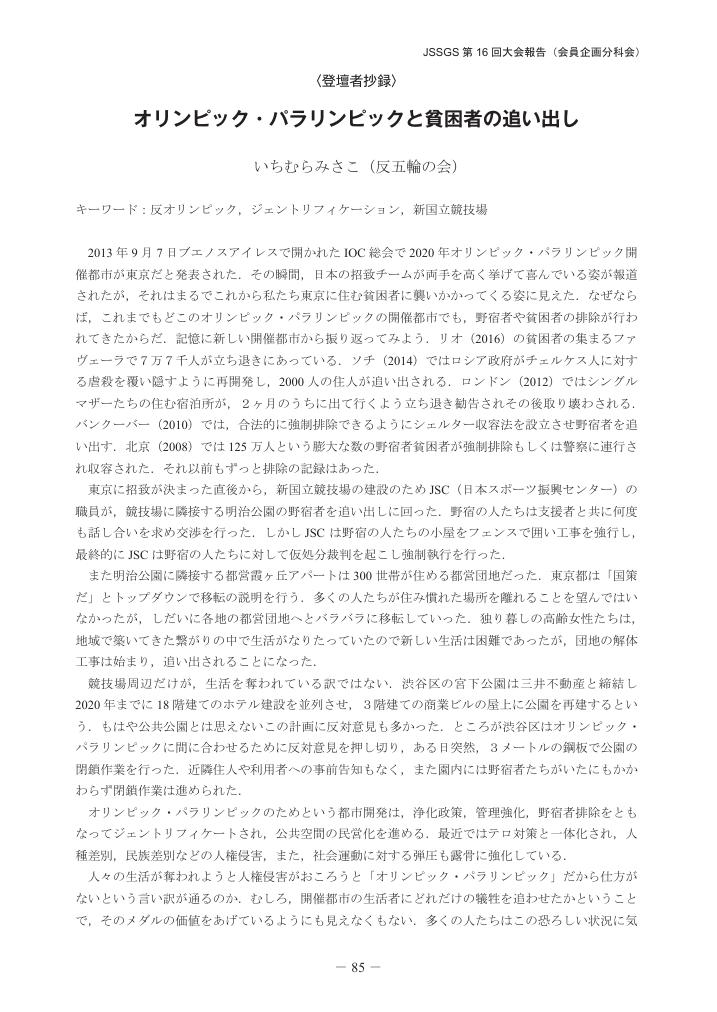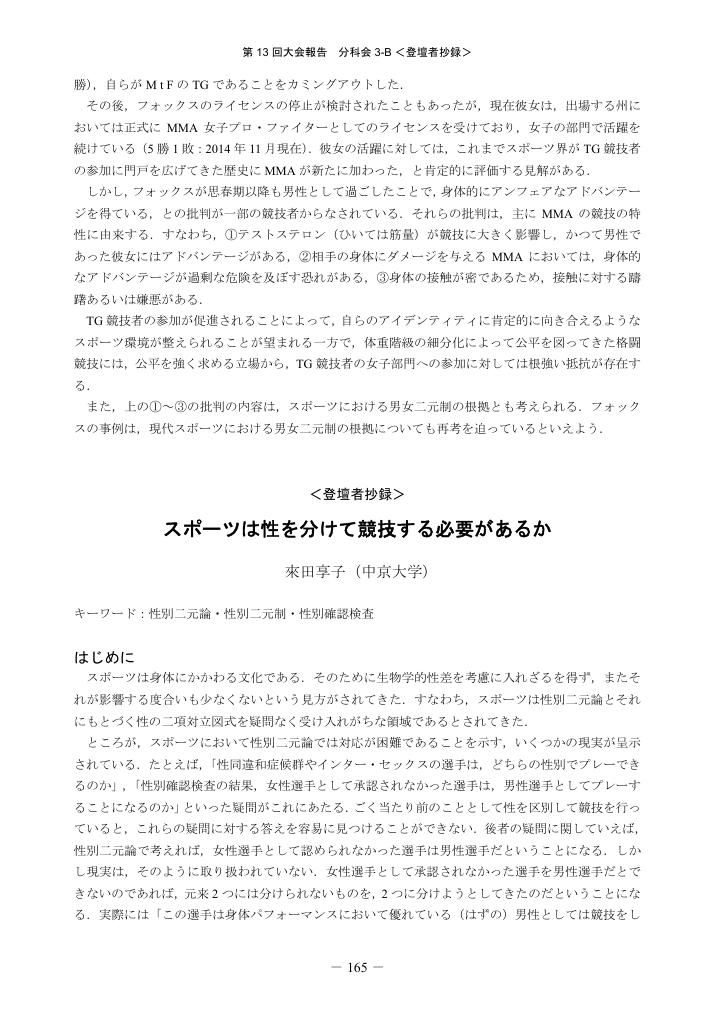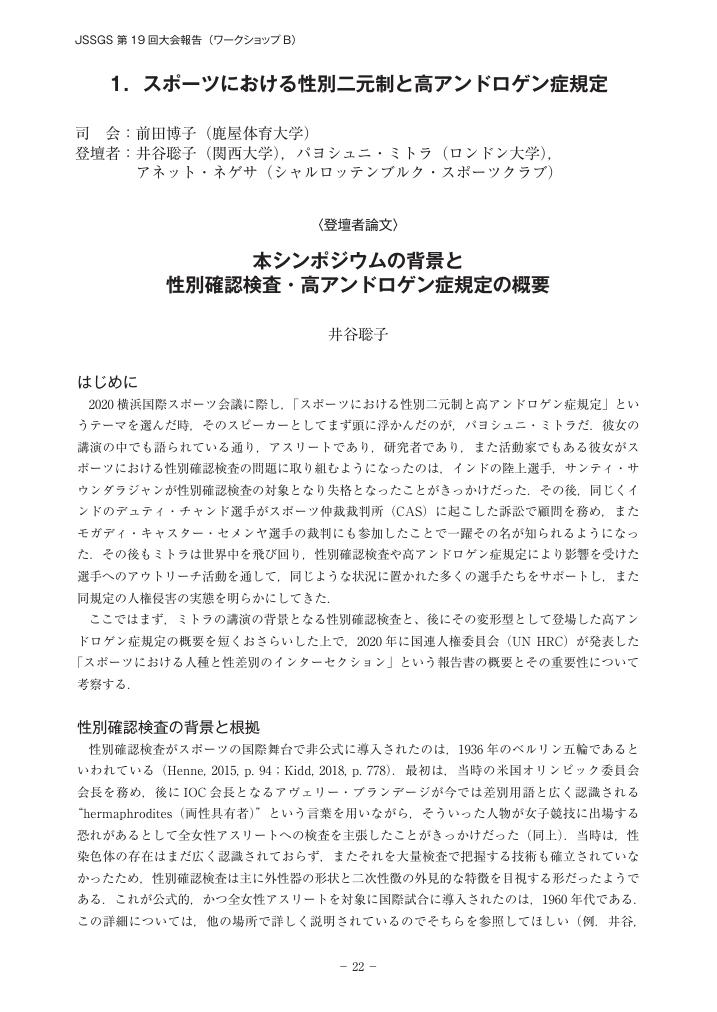108 0 0 0 OA オリンピック・パラリンピックと貧困者の追い出し
- 著者
- いちむら みさこ
- 出版者
- 日本スポーツとジェンダー学会
- 雑誌
- スポーツとジェンダー研究 (ISSN:13482157)
- 巻号頁・発行日
- vol.16, pp.85-86, 2018 (Released:2018-12-29)
51 0 0 0 OA スポーツ・メガイベントの政治とジェンダー研究の視界
- 著者
- 井谷 聡子 井谷 惠子
- 出版者
- 日本スポーツとジェンダー学会
- 雑誌
- スポーツとジェンダー研究 (ISSN:13482157)
- 巻号頁・発行日
- vol.16, pp.48-57, 2018 (Released:2018-12-29)
- 参考文献数
- 36
32 0 0 0 OA 女性化される現代ヨガ 日本におけるブームとその変遷
- 著者
- 入江 恵子
- 出版者
- 日本スポーツとジェンダー学会
- 雑誌
- スポーツとジェンダー研究 (ISSN:13482157)
- 巻号頁・発行日
- vol.13, pp.148-158, 2015 (Released:2017-04-14)
- 参考文献数
- 24
Modern yoga in Japan specializes in certain factors after having experienced three booms in its popularity, including the tendencies of feminization, consumer culture, fashion, medicine, and spirituality. Specifically, feminization is an outstanding characteristic of yoga in Japan as some yoga studios will only permit females to participate. On the other hand, yoga in Japan excludes a religious and/or philosophical element, which is present in yoga practice in other countries. As such, this paper examines how Japanese yoga has been feminized through the elimination of religious factors. For this purpose, this study analyzed the article, autobiographies, and data from the fieldwork. This study found that incidents of religious cults in Japan once damaged the whole yoga community so severely that most yoga studios were banned as a result. One yogi decided to focus on the female population in order to eradicate the stigma attached to yoga, and the social background of “spiritual culture” and “consumer culture” assisted in his arbitrary decision. Finally, the images and the way that yoga is “consumed” in Japan reflect the gender norms of today. Modern yoga in Japan places importance on “healing/relaxing” for beauty, and never mentions enhancing sexual ability like in other countries.
29 0 0 0 OA スポーツ・メガイベントと植民地主義 クイア運動という視点から
- 著者
- 井谷 聡子
- 出版者
- 日本スポーツとジェンダー学会
- 雑誌
- スポーツとジェンダー研究 (ISSN:13482157)
- 巻号頁・発行日
- vol.14, pp.105-117, 2016 (Released:2017-04-25)
- 参考文献数
- 24
To think about the “equity and justice” in the context of sports mega-event, in which power structures overlap and diverse political interests collide, requires complicated and vigorous theoretical and ethical discussions. It is inadequate to consider the issue of equity and justice based on one identity category, such as gender or sexuality, separated from other overriding identities and issues, such as the athletes’ nationality, race, ethnicity, socio-economic status and ability, sponsor’s and host city’s interests, the politics within sports organizations, the impact on the host city’s local communities, environmental destruction and so on. Therefore, it is, crucial to continue the critical engagement with the complicated matrix of power and politics of sports mega-events and to maintain the focus on the experiences of those who are oppressed and marginalized by the sports mega-event in order to take a step towards equity and justice in sport. In this paper, I utilize queer and post-colonial theories to examine the multifaceted power structures and the politics, and the issues oppression and exclusion that are often made invisible in sports mega-events.
28 0 0 0 OA 第6回IWG 女性とスポーツに関する世界会議にみるスポーツとジェンダーの今日的課題
- 著者
- 田原 淳子
- 出版者
- 日本スポーツとジェンダー学会
- 雑誌
- スポーツとジェンダー研究 (ISSN:13482157)
- 巻号頁・発行日
- vol.13, pp.202-215, 2015 (Released:2017-04-14)
- 参考文献数
- 6
26 0 0 0 OA スポーツは性を分けて競技する必要があるか
- 著者
- 來田 享子
- 出版者
- 日本スポーツとジェンダー学会
- 雑誌
- スポーツとジェンダー研究 (ISSN:13482157)
- 巻号頁・発行日
- vol.13, pp.165-168, 2015 (Released:2017-04-14)
- 参考文献数
- 6
26 0 0 0 OA オリンピック,祝賀資本主義,活動家の応答
- 著者
- ボイコフ ジュールス
- 出版者
- 日本スポーツとジェンダー学会
- 雑誌
- スポーツとジェンダー研究 (ISSN:13482157)
- 巻号頁・発行日
- vol.16, pp.62-84, 2018 (Released:2018-12-29)
- 参考文献数
- 44
- 被引用文献数
- 1
本発表は3部構成となっている.まず,第1部で「祝賀資本主義」理論についてその根本的主張を説明しながら紹介し,この理論がナオミ・クラインの「惨事便乗型資本主義」とどのように関係しているかを説明する.祝賀資本主義という概念は,近代オリンピックについての考え方を体系付けるのに有用であり,21世紀におけるオリンピック大会の根幹となる政治的,経済的力学をもっともよく捉えるものであると考える.第2に,特定のオリンピック大会の例を引きながら,祝賀資本主義が開催都市における特定の政策や実践の中でどのような形態をとるのかについて論証する.2010年のバンクーバー冬季オリンピック,2012年のロンドンオリンピック,2014年のソチ(ロシア)冬季オリンピック,そして2016年のリオデジャネイロオリンピックの例を見ながら,祝賀資本主義がいかに反オリンピック運動を刺激しうるかを示す.第3に,東京が2020年のオリンピック大会開催に向けて準備する中で,祝賀資本主義がどのように現れているのかを検証する.
- 著者
- 片岡 栄美
- 出版者
- 日本スポーツとジェンダー学会
- 雑誌
- スポーツとジェンダー研究 (ISSN:13482157)
- 巻号頁・発行日
- vol.17, pp.49-63, 2019
本研究は,ブルデューの男性支配と象徴権力の理論を用いて,日本の大学生におけるスポーツ嗜好のアイデンティティをもつ学生の価値,態度,文化資本を,量的な調査データに基づき明らかにした.体育会系アイデンティティの保持者は男女ともに,ジェンダー役割意識に関する非民主的価値と男性支配的価値を示した.彼らのコミュニケーション能力は高く,かつ男子体育会系の大半が権力志向でもある.とくに男性の体育会系は権威主義的価値観や伝統重視の価値観をより強く持っている.かれらは政治的な無関心を示す傾向が強く,マスメディアの情報を信頼しており,また一般的他者への信頼も高い.それゆえ,かれらは現在の社会体制を疑うことはあまりなく,社会の問題や社会の矛盾に気がつきにくいナイーブな存在でもある.また体育会系学生の文化資本は,他の学生よりも相対的に低かった.これらの価値態度,いいかえれば,ハビトゥスは近い将来の日本の保守的・非民主的な階層フラクションを体現するものである.
20 0 0 0 OA 本シンポジウムの背景と性別確認検査・高アンドロゲン症規定の概要
- 著者
- 井谷 聡子
- 出版者
- 日本スポーツとジェンダー学会
- 雑誌
- スポーツとジェンダー研究 (ISSN:13482157)
- 巻号頁・発行日
- vol.19, pp.22-26, 2021 (Released:2021-10-09)
- 参考文献数
- 8
20 0 0 0 OA スポーツ・ルールにおける平等と公正
- 著者
- 近藤 良享
- 出版者
- 日本スポーツとジェンダー学会
- 雑誌
- スポーツとジェンダー研究 (ISSN:13482157)
- 巻号頁・発行日
- vol.14, pp.121-133, 2016 (Released:2017-04-25)
- 参考文献数
- 17
The topic of equality and fairness in sports rules can be debated from a variety of perspectives. Accordingly, this research seeks to analyze the various theories regarding separate events for men and women discussed by sports philosophers and sports ethicists and proposes the use of a handicapping method. Based on the analysis of theories, it can be concluded that separate events for men and women is currently accepted by sports philosophers and sports ethicists. If a system that could provide both equality of opportunity and equality of results in sports were created, competitors who put in the greatest effort or who were lucky would likely win. The method of achieving this is handicapping or sports standardization. Paul Weiss, a sports philosopher, explains the effects as follows: “Handicaps are imposed so that even if weight, sex, or experience are different, a better competitor can compete equally against a weaker competitor. This imposes a restriction on the better competitor so that he/she is at the same level as others while allowing better conditions or a higher score for the weaker competitor, providing an opportunity to beat a superior athlete on equal terms.” Weiss indicates that the intention of sports standardization is not to encourage participation in sports by more people by making it possible for anyone to win, but rather to provide opportunities for each individual to learn what they can achieve by overcoming limitations such as weight, sex, and experience. Handicapped sports recognize differences in birth, sex, background, competitive ability, values, and so on without eliminating the reasons for the individual differences and create a place for competition. When individuals recognize one another, society as a whole become stronger. The elimination of gender from sports that use handicaps has particular significance in disseminating the strengthening of society itself from the world of sports.
- 著者
- 片岡 栄美
- 出版者
- 日本スポーツとジェンダー学会
- 雑誌
- スポーツとジェンダー研究 (ISSN:13482157)
- 巻号頁・発行日
- vol.17, pp.49-63, 2019 (Released:2019-09-06)
- 参考文献数
- 25
本研究は,ブルデューの男性支配と象徴権力の理論を用いて,日本の大学生におけるスポーツ嗜好のアイデンティティをもつ学生の価値,態度,文化資本を,量的な調査データに基づき明らかにした. 体育会系アイデンティティの保持者は男女ともに,ジェンダー役割意識に関する非民主的価値と男性支配的価値を示した.彼らのコミュニケーション能力は高く,かつ男子体育会系の大半が権力志向でもある.とくに男性の体育会系は権威主義的価値観や伝統重視の価値観をより強く持っている.かれらは政治的な無関心を示す傾向が強く,マスメディアの情報を信頼しており,また一般的他者への信頼も高い.それゆえ,かれらは現在の社会体制を疑うことはあまりなく,社会の問題や社会の矛盾に気がつきにくいナイーブな存在でもある.また体育会系学生の文化資本は,他の学生よりも相対的に低かった.これらの価値態度,いいかえれば,ハビトゥスは近い将来の日本の保守的・非民主的な階層フラクションを体現するものである.
16 0 0 0 OA ホモナショナリズムとスポーツ・メガイベント バンクーバー2010から東京2020オリンピックまで
- 著者
- サイクス ヘザー 関 めぐみ 井谷 聡子
- 出版者
- 日本スポーツとジェンダー学会
- 雑誌
- スポーツとジェンダー研究 (ISSN:13482157)
- 巻号頁・発行日
- vol.16, pp.89-111, 2018 (Released:2018-12-29)
- 参考文献数
- 44
13 0 0 0 OA アネット・ネゲサへのインタビュー (聞き手:パヨシュニ・ミトラ)
- 著者
- ネゲサ アネット ミトラ パヨシュニ 井谷 聡子
- 出版者
- 日本スポーツとジェンダー学会
- 雑誌
- スポーツとジェンダー研究 (ISSN:13482157)
- 巻号頁・発行日
- vol.19, pp.36-44, 2021 (Released:2021-10-09)
- 著者
- 関 めぐみ 三上 純 井谷 惠子 井谷 聡子
- 出版者
- 日本スポーツとジェンダー学会
- 雑誌
- スポーツとジェンダー研究 (ISSN:13482157)
- 巻号頁・発行日
- vol.17, pp.21-31, 2019 (Released:2019-09-06)
- 参考文献数
- 18
This is one of the first studies to explore the experiences and expressions of discrimination, violence and exclusion based on genders, sexualities and the bodies in Physical education (PE) in Japan. Through this research, we hope to gain insight into the gender and sexual politics of Japanese PE. The study was administered in three Japanese universities in 2017. Based on 979 survey responses, we present a preliminary analysis of students reported the experiences of discrimination and exclusion. We conducted the quantitative and qualitative content analysis of 410 (41.9%) survey responses, which answered the open-ended question about negative experience in PE. By using quantitative content analysis software (KH coder), we extracted seven clusters: 1) being scolded for a mistake, 2) being a nuisance to a partner or a team, 3) forced to perform (play) sport or do exercise, 4) swimming, 5) running, 6) class (teaching) methods, and 7) methods of evaluation. The main factors that caused the negative experience are codified to: classmates (category 1), oneself (category 2), teachers (category 3, 6, 7) and exercise characteristics (category 4, 5). When analyzed the result by gender, “normative woman” (cis-gendered, heterosexual) tends to be ashamed that they are not good at sports and their self-respect becomes wounded. On the other hand, “normative man” (cis-gendered, heterosexual) tends to remember the negative experience as those moments when they were blamed by their classmates. The persons of “non-normative” gender/sexuality (transgender and/or non-heterosexual) tend to have more negative experiences based on heterosexism and binary gender system. Our findings suggest that the evaluation criteria set by the curriculum and/or teacher need to be changed. Because the criteria made students’ achievement (or the lack thereof) visible, it leads to the bodily hierarchy. This hierarchy push students who are not athletic into a lower position and marginalize them in the classroom.
8 0 0 0 OA トランスジェンダーおよびインターセックスのスポーツ大会への参加条件緩和肯定度
- 著者
- 谷本 千雅子 高島 亜理沙
- 出版者
- 日本スポーツとジェンダー学会
- 雑誌
- スポーツとジェンダー研究 (ISSN:13482157)
- 巻号頁・発行日
- vol.15, pp.6-21, 2017 (Released:2017-12-10)
- 参考文献数
- 22
The participation of transgender and intersex athletes in sport has been a controversial issue. Since transgender and intersex women have been assumed to have unfair physical advantages over women, they have been excluded from women’s competition over the course of the history of the Olympic Games and other competitive sporting events. On the other hand, in case of the non-competitive sport events such as at school as well as community athletic meets, the sporting opportunities of transgender and intersex individuals have started to be encouraged more and more. These exclusive/ inclusive attitudes toward transgender and intersex women suggest that the degree of tolerance changes depending on the competitiveness/non-competitiveness of the events. The current study, therefore, examined how the competitive attitudes in general influence the tolerance towards participation of transgender and intersex individuals in sport events at various athletic levels. Quantitative data (N=89) ranging in age from 18-65 was gathered from the participants of an LGBT Pride Parade in Nagoya, Japan, regarding their gender and sexual identities, sports experiences, interests in Olympic Games, competitive attitudes, and tolerance towards transgender and intersex athletes participating in sport events, ranging from school and community athletic meets to regional, national and international competitions. Findings revealed that the tolerance level declines as the competitiveness of the event increases, and that people who highly value competitiveness are less likely to be tolerant, especially regarding the most competitive sport events. This means that the value of competition in female sports and respect for human rights of transgender and intersex athletes contradict and exclude each other in women’s sports, one of the arenas where binaries of gender are so concrete.
8 0 0 0 OA 身体フェミニズム:女性の身体的エンパワーメントのために
- 著者
- 合場 敬子
- 出版者
- 日本スポーツとジェンダー学会
- 雑誌
- スポーツとジェンダー研究 (ISSN:13482157)
- 巻号頁・発行日
- vol.12, pp.82-92, 2014 (Released:2017-04-28)
- 参考文献数
- 49
Through research on women professional wrestlers, I found that several wrestlers reinforce their confidence to counter male violence and/or attain physical and/or mental strength by participating sports in schools and engaging professional wrestling. Once they attain physical strength, they do experience “physical empowerment.” On the other hand, many women in contemporary Japan are not physically empowered because girls and women in Japan are not encouraged to develop physical strength and athletic abilities. In addition, they fear male violence. Some wrestlers I interviewed actually rescued some women who were frozen by groping inside trains. Therefore, physical empowerment means a process that women in current Japan, who do not exercise their physical strengths thoroughly, take it back. To realize physical empowerment for women in contemporary Japan, I argue that theories and practices of “physical feminism” should be widely disseminated. What is physical feminism? I define it as practices and movements underpinned by thoughts of feminism that facilitate women to attain physical strength. Physical feminism has two goals at this time. One is encouraging girls and women to participate in physical activities from which girls and women attain various benefits. The other is encouraging girls and women to participate in self-defense programs, which let girls and women acknowledge their power to defend themselves from male violence and feel their own physical strength.
- 著者
- 三上 純
- 出版者
- 日本スポーツとジェンダー学会
- 雑誌
- スポーツとジェンダー研究 (ISSN:13482157)
- 巻号頁・発行日
- vol.18, pp.20-34, 2020
The purpose of this study was to investigate how homophobia is constructed in school physical education. Semi-structured interviews were conducted for 9 students who majored in physical education at A University of Education, and 5 students, three "sexual majority women" (cis-gendered, heterosexual) and two "sexual majority men" (cis-gendered, heterosexual), were selected for the analysis. The contents of interviews were about experiences what they had seen or heard discriminating words and actions in respect to sexuality.The result showed that heterosexism is accepted by getting information through media and school life, and that the consciousness is strengthened through "joke about sexuality" in school life in general. It was assumed that the "joke about sexuality" performed by male athletes inside of school-based extracurricular sports clubs is a tool to feel their "status as 'men'" and to "bond" with other than the targeted person. In addition, it was considered that the coaches actively use "joke about sexuality" with the clear intention of "helping to smooth communication" and "constructing normative masculinity". Furthermore, it was shown that misogyny is also constructed in school-based extracurricular sports clubs by prohibiting romantic love only for female athletes.It was concluded that homophobia and misogyny are artfully created in school-based extracurricular sports clubs, and that homosociality is constructed including coaches in some cases. In this culture, students and athletes are expected that they learn the essentiality of homophobia in sports instruction and become teachers who convey it to the next generation through the mechanism of "occupational socialization into physical education teachers". In the future research, it will be necessary to investigate in more detail how homophobia and misogyny appear in the two relationships between athletes each other, and, athletes and coaches.
7 0 0 0 OA アメリカ合衆国のモータースポーツ界におけるトランスジェンダー及び女性ドライバーの受容
- 著者
- 石田 依子
- 出版者
- 日本スポーツとジェンダー学会
- 雑誌
- スポーツとジェンダー研究 (ISSN:13482157)
- 巻号頁・発行日
- vol.13, pp.169-179, 2015 (Released:2017-04-14)
- 参考文献数
- 9
“Gender equality” has been a critical issue among some ideas of equality, as well as “racial equality,” and has long been pursued through our modern history. It could be said that “Gender Studies,” which has been actively explored since the latter part of the 20th century, is trying to reach its destination these days. Analysis and recognition of human existence not only from a viewpoint of racial idea as ever but from of gender idea mean that more extensive research about human diversity has become to put in practice. It is no exaggeration to say that in our modern society we cannot understand a wealth of human existence without a viewpoint of gender idea. Therefore gender idea has become an active area of academic research so that we in this society feel a much greater sense of equality than any humans in history, in which there was no such thing as “equality.” In our daily life, however, actually do we have a mature sense of proportion for “equality”? It is possible to say that sexual difference between male and female become pronounced especially in sports fields. Most sport events are played separately by sex, which means men and women are never the same in their physical forces. But some cannot separate the sexes, whose best examples are motorsports. The reason simply comes from the fact that there are few female racing drivers so that race events could not be done in separating the sexes. This paper presents an analysis of the gendered bodies in motorsports, especially a sexual minority driver as well as females. A concrete sample here is Terri Leigh O”Connell, who is a former racing driver for NASCAR in the USA. She was born as an intersex individual, not feeling like man although being raised as a male, resulting from having a sex reassignment surgery in 1994. I conducted research about the receptivity for her and her own experiences in the field, showing the results in this paper. And a final purpose of this paper is to argue that how gender difference between the sexes is primordially recognized in motorsports field.
7 0 0 0 OA 「男らしさ」と横綱柏戸の表象
- 著者
- 川野 佐江子
- 出版者
- 日本スポーツとジェンダー学会
- 雑誌
- スポーツとジェンダー研究 (ISSN:13482157)
- 巻号頁・発行日
- vol.14, pp.33-42, 2016 (Released:2017-04-25)
- 参考文献数
- 7
- 著者
- 建石 真公子
- 出版者
- 日本スポーツとジェンダー学会
- 雑誌
- スポーツとジェンダー研究 (ISSN:13482157)
- 巻号頁・発行日
- vol.15, pp.98-106, 2017 (Released:2017-12-10)
- 参考文献数
- 4








